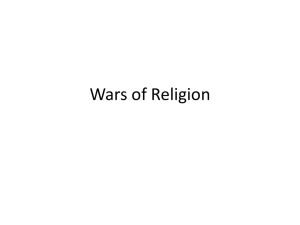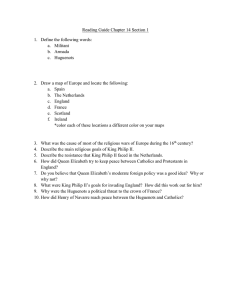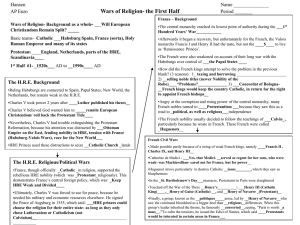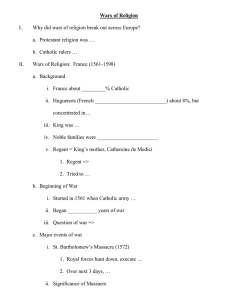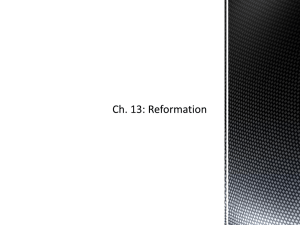Chapter-4-Age-of-Religious-Wars
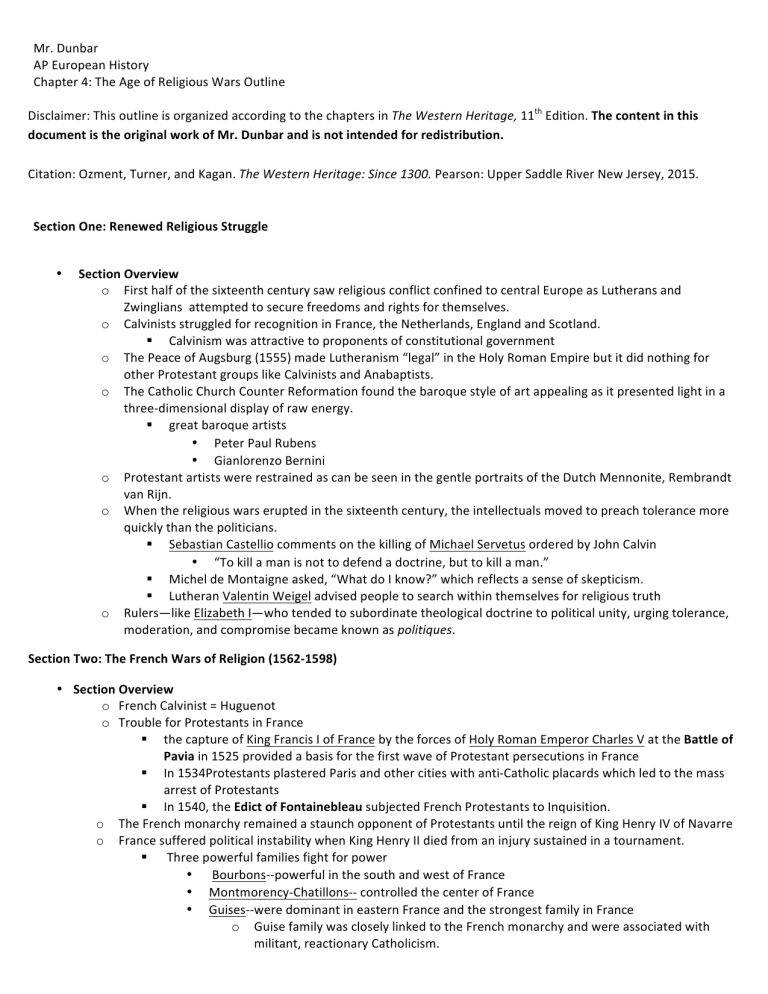
Mr. Dunbar
AP European History
Chapter 4: The Age of Religious Wars Outline
Disclaimer: This outline is organized according to the chapters in The Western Heritage, 11 th Edition. The content in this document is the original work of Mr. Dunbar and is not intended for redistribution.
Citation: Ozment, Turner, and Kagan. The Western Heritage: Since 1300. Pearson: Upper Saddle River New Jersey, 2015.
Section One: Renewed Religious Struggle
•
Section Overview o First half of the sixteenth century saw religious conflict confined to central Europe as Lutherans and
Zwinglians attempted to secure freedoms and rights for themselves.
o Calvinists struggled for recognition in France, the Netherlands, England and Scotland.
§ Calvinism was attractive to proponents of constitutional government o The Peace of Augsburg (1555) made Lutheranism “legal” in the Holy Roman Empire but it did nothing for other Protestant groups like Calvinists and Anabaptists.
o The Catholic Church Counter Reformation found the baroque style of art appealing as it presented light in a three-dimensional display of raw energy.
§ great baroque artists
•
Peter Paul Rubens
•
Gianlorenzo Bernini o Protestant artists were restrained as can be seen in the gentle portraits of the Dutch Mennonite, Rembrandt van Rijn.
o When the religious wars erupted in the sixteenth century, the intellectuals moved to preach tolerance more quickly than the politicians.
§ Sebastian Castellio comments on the killing of Michael Servetus ordered by John Calvin
•
“To kill a man is not to defend a doctrine, but to kill a man.”
§ Michel de Montaigne asked, “What do I know?” which reflects a sense of skepticism.
§ Lutheran Valentin Weigel advised people to search within themselves for religious truth o Rulers—like Elizabeth I—who tended to subordinate theological doctrine to political unity, urging tolerance, moderation, and compromise became known as politiques .
Section Two: The French Wars of Religion (1562-1598)
•
Section Overview o French Calvinist = Huguenot o Trouble for Protestants in France
§ the capture of King Francis I of France by the forces of Holy Roman Emperor Charles V at the Battle of
Pavia in 1525 provided a basis for the first wave of Protestant persecutions in France
§ In 1534Protestants plastered Paris and other cities with anti-Catholic placards which led to the mass arrest of Protestants
§ In 1540, the Edict of Fontainebleau subjected French Protestants to Inquisition. o The French monarchy remained a staunch opponent of Protestants until the reign of King Henry IV of Navarre o France suffered political instability when King Henry II died from an injury sustained in a tournament.
§ Three powerful families fight for power
•
Bourbons--powerful in the south and west of France
•
Montmorency-Chatillons-- controlled the center of France
•
Guises--were dominant in eastern France and the strongest family in France o Guise family was closely linked to the French monarchy and were associated with militant, reactionary Catholicism.
o The Bourbon and Montmorency-Chatillon families developed strong Huguenot sympathies
§ Conspiracy of Amboise —these two families planned—but never carried out— the kidnapping of Francis II of France from his Guise advisors.
•
Appeal of Calvinism o Although Huguenots made up only one-fifteenth of the population, Huguenots held important geographic areas and were heavily represented among the more powerful segments of French society. o Decentralization
§ Huguenots wanted a principle of territorial sovereignty in France like that extended to Protestants by the Peace of Augsburg in the Holy Roman Empire.
§ Calvinism justified and inspired political resistance in France.
•
Catherine de Medici and the Guises o Following the death of Francis II, the queen mother, Catherine de Medici, became regent for her younger son,
Charles IX. o Catherine attempted to resolve conflict between Protestants and Catholics
§ she me with Protestant leaders Theodore Beza and Coligny
§ In 1562, the crown issued the January Edict
• granted Protestants freedom to worship publicly outside towns—although only privately within them. o The Catholic duke of Guise surprised a Protestant congregation in Champagne and massacred many worshipers which ignited the French wars of religion.
§ French monarchy supported the Catholic Guise family o First French war of religion (1562-1563)
§ Duke of Guise was assassinated
§ Troops from Hesse and the Palatinate in the Holy Roman Empire fought alongside the Huguenots o Peace of Saint Germain-en-Laye
§ Huguenots were granted religious freedoms in territories in southern France and the right to fortify their cities. o The crown’s reaction to the Peace of Saint Germain-en-Laye
§ Charles IX established closer with the Bourbon family and the Huguenots in France
§ Meanwhile, Catherine began to plot with the Guise family as she was suspicious of the Huguenots o Saint Bartholomew’s Day Massacre
§ On August 24, 1572 3,000 Huguenots were murdered in Paris and within three days an estimated
20,000 Huguenots were killed throughout France
•
The Huguenot Henry of Navarre had just married the king’s sister four days before this event.
•
Coligny, the Huguenot leader had been shot by an assassin but only wounded
•
Catherine convinced King Charles IX that a Huguenot coup was at hand and that the crown must align with the Guises to prevent it. o Protestant Resistance Theory
§ Initially, Protestants practiced obedient subservience to worldly authority as encouraged in the Bible.
§ In 1550, Lutherans in Magdeburg published an influential defense of the right of lower authorities to oppose the emperor’s order that all Lutherans return to the Catholic fold.
§ Calvin also condemned willful disobedience and rebellion against lawfully sanctioned governments
§ John Knox
•
Scottish reformer who wrote First Blast of the Trumpet against the Terrible Regiment of
Women (1558) which declared that removal of a tyrant was a Christian duty.
§ Three major works of resistance theory
•
Franco-Gallia by Francis Hotman
•
On the Right of Magistrates over their Subjects by Theodore Beza
•
Defense of Liberty Against Tyrants by Philippe du Plessis Mornay
•
The Rise to Power of Henry of Navarre
o Henry III of the Valois family was the last of Henry II’s sons to rule France
§ Henry III attempted to institute moderate religious reforms on France
§ Peace of Beaulieu in May 1576 granted Huguenots almost complete religious and civil freedom.
•
This backfired, however, when the Catholic League forced Henry to agree to attempt to impose absolute religious unity in France
§ Protestant and Catholic fighting in France resumes
•
Henry of Navarre—a legal heir to the French throne by virtue of his descent in a direct male line from Louis IX—led the Protestants
•
The Catholic League was led by the Guise family and was supported by the Spanish.
•
Day of the Barricades o Henry III attempted to rout the Catholic League with a surprise attack in 1588 but failed and was forced to flee Paris. o Henry III had both the duke and cardinal of Guise assassinated. o As a result, Henry III was forced to strike an alliance with the Protestant Henry of
Navarre.
§ a Dominican friar killed King Henry III as he and Henry of Navarre plotted to attack the Guise stronghold of Paris
§ Consequently, the Bourbon Huguenot Henry of Navarre succeeded the childless Valois king to the
French throne as Henry IV o King Henry IV
§ When a Protestant rose to the throne in France, the Spanish King Philip II sent Spanish troops into
France.
§ The Spanish invasion actually helped Henry IV take hold of France as nationalist sentiments took hold
§ Henry IV was a politique
• believed a royal policy of tolerant Catholicism would be the best way to achieve peace.
• he publicly abandoned his Protestant beliefs and embraced Catholicism, the traditional and majority religion of his country
§ Edict of Nantes (April 13, 1598)
•
Recognized minority religious rights
•
Gave Huguenots the freedom of public worship, the right of assembly, admission to public offices and universities, and permission to maintain fortified towns.
§ A Catholic fanatic assassinated Henry IV in May 1610
Section Three: Imperial Spain and Philip II
•
Pillars of Spanish Power o Until England defeated the Spanish Armada in 1588, Philip II was the most powerful monarch in Europe.
o Philip was heir to the intensely Catholic and militarily supreme western Habsburg kingdom.
§ New World Riches
• regular arrival in Seville of bullion from the Spanish colonies in the New World o great silver mines had been opened in present day Bolivia and Mexico in the 1540s o these funds were used to pay the king’s bankers and mercenaries
§ Increased Population
•
As Europe became richer from New World exploits, the population increased rapidly
•
Combination of increased wealth and population triggered inflation.
o more people and more coinage in circulation than before, but less food and fewer jobs o wages stagnated while prices of necessities doubled and tripled
• peasantry of Spain suffered most as they were taxed more heavily than any other group of people in Europe.
§ Efficient Bureaucracy and Military
•
Philip II ruled by the pen rather than by personal presence.
• he organized the lesser nobility into a complex bureaucracy
o Philip’s son Don Carlos died under suspicious circumstances and it was suspected that Philip had him quietly executed.
§ Supremacy in the Mediterranean
• first half of Philip’s reign focused his attention on the Turkish threat.
o by 1560, the Turks had advanced deep into Austria and their fleets dominated the
Mediterranean.
•
Philip’s half brother, Don John of Austria, suppressed and dispersed the Moors in Granada.
•
In May 1571, a Holy League of Spain, Venice, Genoa, and the pope, under Don John’s command, formed to check the Turkish threat.
o Don John’s fleet engaged the Turks and sunk or captured over one third of their fleet and nearly 30,000 Turks had died
•
The Revolt in the Netherlands o Philip II military suffered defeats in the Netherlands, England, and France.
o The Netherlands was the richest area in all of Europe in mid-sixteenth century and Philip II slowly gained control over the region.
o Cardinal Granvelle
§ Philip II appointed his half-sister Margaret of Parma as regent in charge of the Netherlands
§ Cardinal Granvelle appointed as head of Margaret’s council
§ Granville and Margaret of Parma attempted to subdue the seventeen Netherlands provinces and place them under the centralized imperial government of Spain.
§ Many of these provinces were Calvinist strongholds and there was a tremendous amount of hostility towards the Spanish.
§ Count of Egmont and William of Nassau, the prince Orange, led the opposition against Spain
§ Many urban artisans grew hostile towards the Spanish and many joined the congregations of radical
Calvinist preachers.
o The Compromise
§ When Philip II instructed Margaret of Parma to enforce the decrees of the Council of Trent on the
Netherlands, William of Orange’s younger brother, Louis of Nassau, led the opposition with the support of the Calvinist-minded lesser nobility and townspeople.
§ The opposition drafted the Compromise in which they vowed to resist the decrees of the Council of
Trent and the Inquisition.
§ When Margaret’s government called the protesters “beggars” in 1566, Calvinists rioted throughout the country. Louis called for aid from French Huguenots and German Lutherans.
o The Duke of Alba
§ A full scale rebellion against Spain’s influence in the Netherlands never erupted because the higher nobility of the Netherlands would not support it.
§ Philip II sent the duke of Alba—who was accompanied by his army of 10,000 men—from Milan to the Netherlands
• they assembled a special tribunal known to the Spanish as the Council of Troubles and by the people of the Netherlands as the Council of Blood o launched a campaign of terror during which the counts of Egmont and Horn, along with several thousand heretics were publicly executed.
§ Alba spent six years in the Netherlands and during this time he levied new taxes and continually persecuted Protestants.
o Resistance and Unification
§ William of Orange emerged from exile as the leader of the movement for the independence of the
Netherlands from Spain.
•
He led his operation from the provinces of Holland, Zeeland, and Utrecht, of which William was governor.
§ group of pirates which consisted of anti-Spanish exiles and criminals, known as the “Sea Beggars” , captured port cities and incited rebellions against the Spanish in coastal towns of the Netherlands.
§ Alba had by this time ceded power to Don Luis de Requesens, who replaced him as commander of the Spanish forces in the Netherlands.
o The Pacification of Ghent
§ Spanish Fury
• after the death of Requesens, Spanish mercenaries who were leaderless and unpaid, ran amok in Antwerp on November 4, 1576, leaving 7,000 people dead.
§ The Pacification of Ghent
• agreement between the largely Catholic provinces of the south (modern-day Belgium) and the largely Protestant northern provinces (modern-day Netherlands)in which the merged in opposition to Spain.
§ Perpetual Edict
• a united Netherlands defeated the Spanish
• the edict which required the removal of all Spanish forces from the Netherlands within the next twenty days.
o The Union of Arras and the Union of Utrecht
§ Don John and Alexander Farnese of Parma, the Regent Margaret’s son, revived Spanish power in southern provinces
•
Southern provinces feared Calvinist extremism leading them to drop out of the union.
§ In 1579, the southern provinces formed the Union of Arras and made peace with Spain and the northern provinces responded by forming the union of Utrecht.
o Netherlands Independence
§ Philip II declared William of Orange an outlaw and placed a bounty of 25,000 crowns on his head.
§ The Apology
•
Famous speech delivered by William of Orange to the Estates General in Holland
•
Union of Utrecht met in the Hague and formally declared Philip II no longer their ruler.
§ Union of Utrecht offered the crown of the Netherlands to the French duke of Alencon
• he was expected to act as a “titular” ruler.
• when he attempted to take actual control of the provinces in 1583, he was deposed and returned to France.
§ William of Orange was assassinated in 1584 and was succeeded by his son Maurice who continued the Dutch resistance.
§ Philip II got involved in conflicts in France and England which allowed the Netherlands to strengthen and prosper economically.
Section Four: England and Spain
•
Section Overview o Edward VI’s government named Lady Jane Grey successor to the throne in England rather than Mary Tudor, the Catholic daughter of Henry VIII
§ Lady Jane Grey
• teenage daughter of a powerful Protestant nobleman and the granddaughter (on her mother’s side)of Henry VIII’s younger sister Mary o Supporters of the concept of hereditary monarchy launched a series of uprisings in London and Mary Tudor was named queen of England
•
Mary I (1553-1558) o Mary married Philip of Spain (later Philip II) and established a powerful Catholic alliance o Mary passed legislation through Parliament that reverted to Catholicism and she ordered the executions of the Protestant leaders of the Edwardian Age including John Hooper, Hugh Latimer, and Thomas Cranmer. o 287 Protestants were burned at the stake during Mary’s reign, while many others—known as “Marian exiles”—fled to the Continent and settled in Germany and Switzerland.
•
Elizabethan England (1558-1603) o Queen Elizabeth I
§ passed a series of legislation through Parliament that guided a religious settlement that ended religious civil strife in England. o Religious Legislation
§ Act of Supremacy (1559) repealed all the anti-Protestant legislation of Mary Tudor.
§ Act of Uniformity (1559) issued a revised edition of the second Book of Common Prayer .
§ In 1563, the Thirty Nine Articles was issued that made a moderate Protestantism the official religion within the Church of England o Catholic and Protestant Extremists
§ Catholic extremists hoped to replace Elizabeth with Mary Stuart, Queen of Scots, who had a claim to the throne since her grandmother, Margaret, was the sister of Henry VIII.
§ Elizabeth showed little mercy for Catholics who attempted to destroy the unity of England; however, she executed far fewer Catholics during her 45 years on the throne than Mary had Protestants in just five years.
§ The Puritans emerged during her reign who wanted to purify the Church of England of “every vestige of popery” and they were led by Thomas Cartwright.
§ Congregationalists were the more extreme Puritans who wanted every congregation to be autonomous.
•
Conventicle Act of 1593 o Elizabeth had little tolerance for the independence-minded Congregationalists and gave them the option to conform or face exile or death. o Deterioration of Relations with Spain
§ Elizabeth sent English troops to help repel the Spanish invasion of the Netherlands
§ Francis Drake circumnavigated the globe between 1577 and 1580 and rivaled the Spanish for superiority at sea o Mary, Queen of Scots
§ Early Life
•
Daughter of King James V of Scotland and Mary of Guise
• lived in France throughout her childhood and married the French king Francis II
• when Francis II died, she moved back to Scotland and took the throne
§ Mary rules Scotland
• she faced resistance from religious reformers like John Knox because Catholicism was illegal in Scotland
§ Mary fled Scotland for England in 1568
•
Mary was forced to flee from Scotland to England and abdicated the throne in 1568
•
James VI, Mary’s son, succeeded her to throne of Scotland
•
Catholics in England plotted against Elizabeth in an attempt to put Mary on the throne o Mary was placed under house arrest for nineteen years.
§ Plots Against Elizabeth
•
Elizabeth’s secretary—Sir Francis Walsingham—uncovered a plot against the queen that was planned by the ambassador of Spain Bernardino de Mendoza.
•
Babington Plot o A man named Anthony Babington was caught seeking Spanish support for an attempt on the queen’s life. o Mary, Queen of Scots, was involved in the plot
§ Elizabeth ordered the execution of Mary, Queen of Scots which took place on February 18, 1587.
•
Since Elizabeth ordered the execution of a Catholic queen, Pope Sixtus V publicly announced his support for Catholic Spain’s invasion of Protestant England. o The Armada
§ As the Spanish prepared for attack in the spring of 1587, Sir Francis Drake shelled the port of Cadiz which severely interrupted Spain’s mobilization efforts.
§ On May 30, 1588 the Armada set sail for England with 130 ships and 25,000 in which they lost in devastating fashion.
§ Smaller and faster ships enabled the English and Netherlands’ ships disperse the Spanish fleet
§ A storm, which became known as the English Wind or Protestant Wind, assisted the English by blowing the Spanish ships off course. o Section conclusion
§ By the time of Philip’s death in 1598 his forces had been stifled on all sides and its overseas empire in the New World was pecked away at by the English and the Dutch.
§ France succeeded Spain as the dominant nation on the Continent.
§ When Elizabeth died on March 23, 1603, she left behind a strong nation ready to expand into a global empire.
Section Five: The Thirty Years’ War (1618-1648)
•
Section Overview o This war—which took place in the Holy Roman Empire—was the last and most destructive of the wars of religion. o Bitter hatreds between Catholics, Protestants, Calvinists, and Lutherans set the stage for a long struggle. o The peace that was established in 1648 at the conclusion of the war shaped the map of northern Europe much as we know it today.
•
Preconditions For War o Fragmented Germany
§ Germany was divided into 360 autonomous political entities and each was granted religious independence by the Peace of Augsburg.
§ There had been longstanding feuds between the Catholic Habsburg emperors and the territorial princes within the empire o Religious Division
§ The population of the Holy Roman Empire was equally divided between Protestants and Catholics.
§ Lutheran had been more successful in securing the right to worship in Catholic areas than the
Catholics had been in securing such rights in Lutheran lands.
§ Catholic rulers demanded that every ecclesiastical prince, electors, archbishops, bishops, and abbots who had deserted the Catholic for the Protestant side be deprived of their religious office and that their land holdings be returned to Catholic control.
•
The Lutherans and Calvinists in the Palatinate ignored this stipulation.
§ There was internal feuding within Protestantism as there were liberal and conservative Lutherans and infighting between Calvinists and Lutherans. o Calvinism and the Palatinate
§ Frederick III and Calvinism
• ruler of the Palatinate who made Calvinism its official religion
§ Palatinate Calvinists established defensive alliances with powerful anti-Spanish (or Habsburg) nations like England, France, and the Netherlands.
§ Calvinists launched strong missionary efforts throughout the Holy Roman Empire and became a threat not only to Catholics but also to the Lutherans. o Maximilian of Bavaria and the Catholic League
§ Bavaria became the center of the Counter Reformation led by the Jesuits who were successful in winning major cities such as Strasbourg and Osnabruck back to Catholicism.
§ Maximilian I, duke of Bavaria, organized a Catholic League to counter the Protestant system of alliances.
§ The Catholic League fielded a great army under the command of Count Johann von Tilly and the stage was set for the Thirty Years’ War.
•
Four Periods of War o The Bohemian Period
§ Ferdinand of Styria
• member of the Catholic Habsburg family
•
came to the throne of Bohemia in 1618
• determined to restore this Protestant region to Catholicism and immediately revoked the religious freedoms of Bohemian Protestants
§ “Defenestration of Prague”
•
Protestant nobility in Prague responded by throwing Ferdinand’s regents out the window of a royal palace
• none of the officials died from the fall
§ Ferdinand was named Holy Roman Emperor Ferdinand II unanimously by the seven electors; in response,
§ the Bohemians declared the Calvinist leader of the Palatinate , Frederick V, their king.
§ Ferdinand’s army routed Frederick V’s troops at the Battle of White Mountain in 1620 o The Danish Period
§ The Lutheran King Christian IV—with the encouragement of England, France, and the Netherlands— marched his army into Germany and was quickly humiliated and forced to retreat.
§ Ferdinand was assisted in his re-Catholicization by Albrecht of Wallenstein who led an army of
100,000 men into Denmark which completely crushed the Protestant resistance.
§ Edict of Restitution in 1629
• reaffirmed the illegality of Calvinism
• ordered the return of all church lands the Lutherans had acquired since 1552 o The Swedish Period
§ Gustavus Adolphus II of Sweden, a pious king of a unified Lutheran nation, became the new leader of
Protestant forces
•
He was supported by the French minister Cardinal Richelieu and the Dutch, who both had interested in seeing the weakening of the Habsburgs.
•
The Swedish king led a Protestant alliance to a decisive victory at Breitenfeld in 1630 which changed the momentum of the war.
•
Key to the Swedish success was the masterful planning of Gustavus Adolphus who brought new mobility to warfare by having both his infantry and cavalry employ fire-and-charge tactics
•
Gustavus Adolphus was killed by Wallenstein’s forces at the Battle of Lutzen .
•
Emperor Ferdinand II, who had been aligned with Wallenstein, ordered his assassination in
1634 because he feared his growing independence.
§ Peace of Prague in 1635
•
This was a compromise between Emperor Ferdinand II and the German Protestant states.
•
Sweden—supported by France and the Netherlands—refused to join the agreement. o The Swedish-Franco Phase
§ The French openly joined the war in 1635 and the war dragged on for thirteen years, as French,
Swedish, and Spanish soldiers fought and looted throughout Germany.
§ The war completely devastated Germany and experts estimate that nearly a third of Germany’s population perished in the conflict.
•
The Treaty of Westphalia o This document was written in French—rather than Latin—which became the international diplomatic language and symbolized the dominance of France in Europe. o It nullified the Edict of Restitution and asserted the legality of the Peace of Augsburg that had been instituted ninety-three years earlier. o The Independence of the Swiss Confederacy and the United Provinces of the Netherlands were now legally recognized as independent. o The Pope opposed the treaty—but had no power to interfere—because it broadened the legal status of
Protestants. o Warfare continued between France and Spain, outside the Holy Roman Empire—until the French forced the
Spanish to sign the Treaty of the Pyrenees. o The Treaty of Westphalia kept Germany fragmented. o Two German states, Austria and Prussia, would gain international status during the seventeenth century. o As a result of the Treaty of Westphalia, distinctive nation-states, each with their own political, cultural, and religious identity, reached full maturity and firmly established the competitive nationalism of the modern world.
